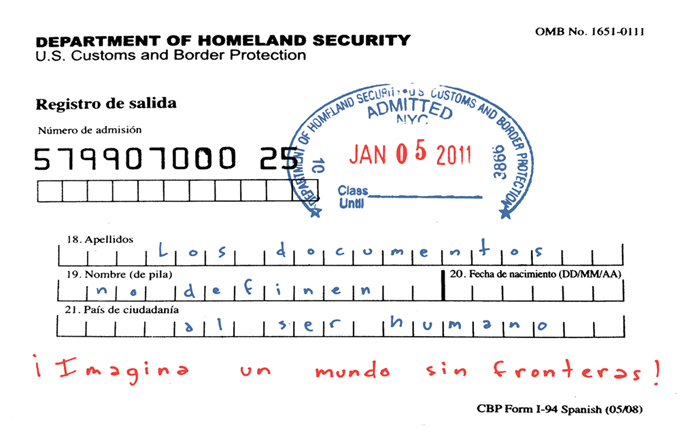
Kevin Caplicki, ¡Imagina un mundo sin fronteras!, 2012.
It is one of those moments an editor longs for—when the publication of a commissioned piece resonates immediately with a historical event. In this case, the event was the announcement by the Associated Press that it would drop the term “illegal immigrant” from the AP Stylebook—a style guide used by virtually all American news publications.
I first heard the news in an email directly from the AP:
Editor’s Note: A New entry on illegal immigration has been added to replace the entry on illegal immigrant.
+++++++++++++++++
illegal immigration
Entering or residing in violation of civil or criminal law. Except in direct quotes essential to the story, use illegal only to refer to an action, not a person: illegal immigration, but not illegal immigrant. Acceptable variations including living in or entering a country illegally or without legal permission.
Except in direct quotations, do not use the terms illegal alien, an illegal, illegals or undocumented.
The moment was a major victory for many activists and artists who campaigned to eliminate a phrase they consider hateful, including Creative Time Reports correspondents Roberto Lovato, Negin Farsad and Favianna Rodriguez, who confronted the cultural conversation on immigration in her article published this month. Days after the Defense of Marriage Act was challenged in a landmark Supreme Court case, Rodriguez reflected on how social change happens in “Change the Culture, Change the World,” asserting that “Art is where we can change the narrative, because it’s where people can imagine what change looks and feels like.” Rodriguez compares the growing immigrant rights movement to the gradual mainstreaming of LGBTQ culture, and asks us to imagine “what it would be like if we could have a Laramie Project for immigrant rights, a play about undocumented youth, become popular in high schools. How long would it take us to get to a place where migration was viewed as normal and natural, and where we respected the human rights of people who have crossed national borders?”
As our network of artists grows, we continue to present undercurrents and modes of engagement that often fall outside the mainstream media’s purview. Whether through a piece like Mariam Ghani and Chitra Ganesh’s, which examines Guantanamo through a myriad of sources—including hand-painted portraits of detainees and declassified government documents—as a military doctrine that extends far beyond the walls of the prison and “has proliferated like a self-replicating virus in various permutations across the globe,” or a podcast from the radio collective I ran into Iran that examines how an emancipatory anthem in Chile found its way to Iran during the 1979 revolution, our contributors constantly upend traditional takes on key issues.
We are deeply grateful to be a home for pieces like these that are both fostering much-needed conversations and transforming ways of thinking about issues around the world.
–Marisa Mazria Katz
@marisamazriak

